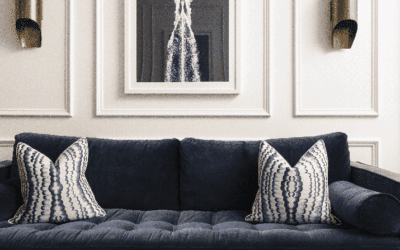Have you ever found yourself feeling drained or resentful after spending time with a partner, even though you love them? Maybe it’s a small request that seems harmless—helping out with something after work or skipping your self-care routine to accommodate their needs—but over time, these small tasks pile up, leaving you exhausted. You might wonder why you’re feeling this way in a relationship that’s supposed to support and nourish you. This could be a sign that your boundaries are being crossed.
As a licensed psychotherapist who helps clients navigate the complexities of boundaries in relationships, I believe that setting clear boundaries is crucial for safeguarding our emotional well-being. They foster mutual respect, ensure we remain true to ourselves, and create space for personal and relational growth. Without them, relationships can feel suffocating or even toxic. In this blog, I want to share how to establish and maintain healthy boundaries in relationships, so you can protect your emotional balance and enjoy a thriving partnership.
Why Boundaries Are Essential for Healthy Relationships
Understanding Boundaries and Their Role in Relationships
At its core, a boundary is a personal limit we set to protect our emotional, physical, and mental well-being. Boundaries help us define where we end, and another person begins. They allow us to communicate our needs clearly while respecting those of others.
Types of Boundaries You Need in Healthy Relationships
There are several types of boundaries we need to consider in our relationships, including:
Emotional Boundaries
Emotional boundaries protect our inner emotional world and allow us to manage how we respond to others. They enable us to assert our feelings and needs without fear of being dismissed or invalidated. For example, if your partner frequently dismisses your feelings by saying, “You’re overreacting,” setting an emotional boundary might involve calmly stating, “I need you to take my feelings seriously. This is important to me, and I would appreciate it if you could listen without judgment.”
Physical Boundaries
Physical boundaries involve the space, touch, and physical needs we set around our bodies. These boundaries dictate how much physical closeness we are comfortable with. For instance, if your partner likes to be physically affectionate but you need personal space, a physical boundary might be, “I need some time to myself when I get home from work before we hug or cuddle. It helps me decompress.”
At its core, a boundary is a personal limit we set to protect our emotional, physical, and mental well-being.
In more extreme cases, violating physical boundaries includes laying hands on someone without their consent, throwing objects, or creating physically dangerous situations like reckless driving during an argument.
Intellectual Boundaries
Intellectual boundaries ensure that our thoughts, opinions, and beliefs are valued and respected. These boundaries create a safe space where differences of opinion can be shared without fear of ridicule or dismissal. For example, if you and your partner have differing political views, you might say, “I respect that we have different perspectives, but I need you to listen without trying to change my opinion.”
Time Boundaries
Time boundaries protect how we allocate our time between work, personal life, and relationships. They help maintain a balance between our individual needs and our commitments to others. For example, if your partner expects you to drop everything to spend time together, a time boundary might be, “I love spending time with you, but I need to focus on my work until 6 PM. Let’s plan to hang out afterward.”
Emotional boundaries protect our inner emotional world and allow us to manage how we respond to others.

Common Myths About Boundaries: Why They’re Often Misunderstood
Because boundaries are often misunderstood, many people believe that establishing a boundary means telling someone else how to behave and expecting them to comply. This misconception can lead to frustration and disappointment when the other person doesn’t follow through. In reality, boundaries are not about controlling another person’s actions—they’re about clearly defining what you will or will not engage with, and how you’ll respond based on their behavior. Boundaries are more about self-management than managing others.
Boundaries are not barriers designed to keep others out—they are essential tools for creating healthy, respectful exchanges between partners.
In my experience as a licensed psychotherapist, I’ve found that many people struggle with boundaries because they come from environments where setting limits was either discouraged or misunderstood. For some, growing up in families where their emotional needs were minimized or disregarded makes it difficult to recognize their right to assert boundaries in relationships. As a result, many of my clients worry that establishing boundaries will make them seem selfish or drive their partner away. This fear is rooted in the myth that boundaries are about being controlling or demanding.
However, boundaries are not barriers designed to keep others out—they are essential tools for creating healthy, respectful exchanges between partners. Far from being selfish, they allow both people to maintain emotional safety and autonomy. Without boundaries, one partner’s needs may be overlooked, leading to resentment, frustration, or burnout. Another common myth is that boundaries will create distance or tension in relationships, but in truth, they help prevent enmeshment and allow individuals to maintain their own sense of identity. By fostering mutual respect and clear communication, boundaries actually enhance emotional intimacy and prevent feelings of suffocation.
Far from being selfish, boundaries allow individuals to maintain emotional safety and autonomy.

Are Your Boundaries Being Crossed? Key Signs to Watch For
If you’re unsure whether your boundaries are being violated, here are some clear signs to look out for in your relationship:
-
Feeling Resentful, Guilty, or Angry: You often agree to things but feel negative emotions afterward, signaling you’re not honoring your own needs.
-
Disregard for Your Time: Your partner consistently expects you to drop your plans or doesn’t respect your personal schedule.
-
Dismissing Your Feelings: They downplay or invalidate your emotions, making you feel like your needs don’t matter.
-
Emotional Manipulation: Your partner uses guilt or pressure to get their way, making it difficult for you to assert yourself.
-
Codependency: You feel overly responsible for their emotions and well-being, often putting their needs before your own.
-
Emotional Exhaustion: Ignoring your boundaries leads to burnout, leaving you feeling drained and disconnected from yourself.
-
Crossing Physical Boundaries: This goes beyond simply invading your personal space. It can include destroying personal items you care about, being cruel to pets, throwing objects during arguments, or even reckless behavior like driving dangerously to intimidate you. In more extreme cases, it involves physical harm, such as slapping, hitting, punching, or strangling.
If you’re experiencing any of these signs, it may be time to reassess and set firmer boundaries for your well-being. In cases where your boundaries are continually disrespected or your physical safety is at risk, it’s crucial to consider leaving the relationship to protect yourself.
Are you noticing unhealthy relationship patterns in your own relationship or someone else’s? If you haven’t already, I encourage you to read my recent blog, Red Flags vs Green Flags: How to Recognize Healthy and Unhealth Relationship Patterns.
Simple Steps to Set Healthy Boundaries with Your Partner
Step 1: Cultivate Self-Awareness Around Your Needs
The first step in establishing boundaries is understanding your own emotional and personal needs. Ask yourself: What makes me feel uncomfortable? When do I feel overwhelmed in my relationship? Self-awareness is crucial before setting clear boundaries.
Step 2: Define and Communicate Your Boundaries
Once you understand your needs, it’s time to define your boundaries. For example, you might need time alone after work to recharge, or you may want to maintain friendships outside the relationship. I often work with clients on defining their preferred limits as these can help you feel more in control of your emotional well-being. Creating a fulfilling life that doesn’t just revolve around your partner will help lead you to being a better partner within the relationship.
Step 3: How to Have an Effective Boundaries Conversation
Outlining boundaries requires open communication, but it’s important to understand what a boundary actually is—and what it isn’t. A common misconception is that creating a boundary means telling someone else what to do, and then becoming frustrated or angry when they don’t follow through. In reality, boundaries are about defining what you will or will not engage with, and what you will or will not do as a result of the other person’s behavior.
For example, rather than saying, “You need to stop raising your voice at me,” which focuses on controlling the other person’s actions, a boundary would sound more like, “If you continue to raise your voice during our conversations, I will walk away and we can revisit this discussion when we’re both calm.” This puts the focus on what you will do in response to the situation, rather than trying to control their behavior.
By defining your actions instead of dictating theirs, you take responsibility for protecting your emotional and physical well-being. This approach also avoids unnecessary power struggles and fosters healthier communication. When expressing boundaries, approach the conversation with compassion and clarity, using “I” statements to express how you feel and what you need (e.g., “I feel overwhelmed when we argue late at night”). This keeps the focus on your experience and makes it easier for your partner to understand without feeling blamed or attacked.
By clearly stating what you will or will not tolerate—and what actions you’ll take if your boundary isn’t respected—you empower yourself to uphold those limits in a way that benefits both partners.
Step 4: Start Small and Gradually Expand Boundaries
Start with smaller boundaries and build from there. For example, you could begin by asking for an hour of alone time each evening. As you see success in maintaining that boundary, expand it as necessary. Small steps build trust and mutual respect between you and your partner.

As you see success in maintaining that boundary, expand it as necessary. Small steps build trust and mutual respect between you and your partner.
Overcoming Common Boundary-Setting Challenges in Relationships
Fear of Conflict: How to Stop Avoiding Boundaries
Fear of conflict often stops people from defining their boundaries. However, conflict is not inherently bad. In fact, it’s a sign of growth in a relationship. Reframing conflict as an opportunity for deeper understanding can make it easier to assert your boundaries. It also encourages honest and open communication.
When Your Partner Ignores Your Boundaries
If your partner doesn’t respect your boundaries after clear communication, it might be time to seek therapy. Working with a therapist can provide tools to navigate these challenges, or, in some cases, help you determine if the relationship is sustainable.
It’s important to find the balance between asserting your boundaries and maintaining emotional intimacy. This balance is built on trust—when both partners trust that their needs are respected, emotional closeness naturally follows.
The Transformative Benefits of Boundaries
Boundary-setting can be a transformative experience for my clients. As they begin to assert their needs, they often see their relationships evolve—becoming more respectful, balanced, and fulfilling. However, it’s important to remember that this isn’t always easy, and some people may push back or test your limits. Just because you set a boundary doesn’t mean it will automatically be respected, so it’s crucial to stay firm. Here’s what you might encounter and the benefits you’ll experience:
What to Expect When You Set Boundaries:
-
Family or friends might get upset or defensive.
-
People may try to test or push your boundaries.
-
Some may guilt-trip or try to make you feel selfish.
-
There could be an adjustment period as relationships recalibrate.
As a Result of Honoring Your Needs, You May Experience:
-
Reduced stress and anxiety as your needs are honored.
-
Stronger, more respectful relationships.
-
Clearer communication and fewer misunderstandings.
-
A deeper sense of self-worth and empowerment.
-
More fulfilling and balanced connections with others.
-
Feeling more grounded and connected to your thoughts and emotions.
-
Living in a way that feels authentic and aligned with your inner self.
Creating healthy boundaries can be challenging, but the long-term benefits for your emotional well-being and relationships are worth it.
Take the First Step Toward Better Boundaries
Remember, setting boundaries isn’t just an act of self-care—it’s a necessary skill for fostering healthy, loving relationships. As we’ve discussed, boundaries protect our emotional well-being, enhance communication, and deepen intimacy. Whether you’re navigating a new relationship or looking to improve an existing one, take time to reflect on your own needs and communicate them clearly. It’s an ongoing process that leads to stronger, more fulfilling connections.
As a licensed therapist specializing in relationships and working with women, I offer personalized guidance and strategies to help you build healthier, more balanced connections. I encourage you to contact me for a free consultation and take the first step toward creating a relationship that honors your emotional well-being.




